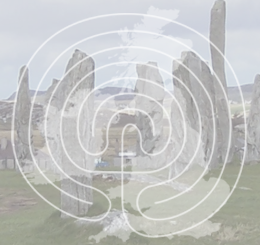The Devil’s Arrows
The Devil’s Arrows are three Neolithic Megaliths – the tallest of which is 23 feet high – standing in a crooked alignment of around 580 feet. The fourth stone was destroyed in the 16th century, when Camden noted that it had been pulled down by treasure seekers.
 In legend they were thrown by the Devil from Howe Hill to destroy Aldborough, hence their common name.
In legend they were thrown by the Devil from Howe Hill to destroy Aldborough, hence their common name.
Directions: Located to the East of Boroughbridge, close to the A1M.




Re: The Devil’s Arrows
According to ‘Yorkshire Legends and Traditions’ by Rev Thomas Parkinson (1888)
The Devil’s Arrows or Bolts.
Near to Aldborough, the ancient Iseur of the British, and Isurium of the Roman times, and still nearer to the more modern town of Boroughbridge, stand three stone obelisks (formerly there were four), which have in all historic times taxed the curiosity of observers, and the ingenuity of inquirers, to account for the manner in which they have come to be where they are, and for their original object or purpose.
They are massive stone pillars calculated to weigh from 30 to 36 tons each, standing upright in a line running nearly north and south, the second at the distance of 66 yards from the first, and the third at 120 yards from the second, each having about two yards of its base embedded in the earth. They are known as the Devil’s Bolts, or the Devil’s Arrows, and legend thus explains their name, and what learned men have yet been unable satisfactorily to do their origin and original use also.
In the days when Iseur was the capital of the Brigantine Kingdom, and the king of that powerful British tribe reigned in that city, there came thither a small band of the first Christian missionaries who visited this country.
They expounded before the king and his nobles their new doctrine, and exhorted them to forsake their Druidical gods and become followers of Christ. The king appointed a conference, at which he would preside, of his chiefs, the Druids of his kingdom, and the missionaries. This was held near Roulstone Scar [Roulston Scar], on the slope of the Hambleton Hills.
As the discussion was proceeding, and the cause of the Christian teachers was winning its way, the assembly was joined by a strange Druid of commanding and venerable appearance. At the king’s request this stranger took a place among them, and listened to the further exposition of the new faith. He then arose, and by gibe and taunt and sneer ridiculed the teaching of the strangers, and upheld the tenets and advantages of Druidism so effectually that a murmur of applause ran through the assembly. When he sat down the king arose and said; ‘Venerable priest, thou speakest well; thy words are truth. These strangers must now leave our shores and return to the land whence they came, for we are unable to accept what they conceive to be truth.’
Fortunately, however, one of the missionaries had noticed, as this venerable arch-Druid had raised his garment somewhat by the earnestness of his action while speaking, that his feet appeared to be sinking into the rock on which he stood, and that the hard stone was partly liquified around them. At once it flashed upon the observer’s mind who the opponent was with whom they had to deal. He there and then challenged him as the great arch-fiend the enemy of all righteousness — against whom they had been warning the assembly, and cried in a stern voice: ‘Satan, I defy thee! In the name of Him whom thou hast reviled, command thee to show thyself who thou art, and to depart to the hell whence thou camest’
At once he was unmasked, and stood forth in all his hideousness in the sight of all present. Then amid sulphurous emanations, and the execrations of those who had so nearly been his dupes, he took his flight. But, being unable to extricate his feet from the semi-molten rock on which he stood, he bore away with him a large mass of that rock adhering to them, until, in passing over How Hill, some six or seven miles to the west of Iseur, the mass became loosened and dropped to the ground.
Some time afterwards he conceived the idea of turning to account his late burden, as an instrument for the annihilation of the now Christian city of Iseur. He therefore rewinged his flight to How Hill, cut up the mass of rock into four large ‘bolts’ or arrows and, planting his feet firmly, one on the front and the other behind the hill, he addressed the doomed town in the words, which some more mundane being must have heard, for they have ever since been reported from mouth to mouth;
Borobrigg, Borobrigg,
Keep out of the way,
For Auldboro’ town
I’ll ding down to-day.’
And then he hurled— we are not told whether with his hands, after the manner of hurling a javelin, or as bolts from a gigantic crossbow, or as arrows from a long bow, but somehow, he hurled the ponderous stones at the town. They were all, however, by some means, intercepted when far short of their goal, and fell, each in the place it has since occupied, one end firmly embedding itself in the earth and keeping the rest in an upright, or nearly upright, position, memorials for all time of the impotence of Satan’s wrath, and of his
intended evil averted from the faithful city.
The similarity of this story to one in Ireland is very remarkable. Close to the ancient city of Cashel, in Tipperary, is an enormous isolated mass of rock known as the Rock of Cashel. Upon it stands some of the most interesting ruins in that historically interesting country. At the foot of this rock is a detached portion, smaller, but weighing many tons, and known as St. Patrick’s Ball, or Arrow.
Far away, some twenty or more miles to the north, is the lofty range of Slieve-Bloom mountains, in a prominent peak in the southern part of which is a large and very noticeable indentation, supposed to correspond somewhat in outline with the rock at Cashel. This peak is called * The Devil’s Bit, or Bite ‘ Mountain. The legend is briefly this : The devil on one occasion in these mountains met with St. Patrick, and, being worsted in a controversy into which he entered with him, at his departing he seized with his teeth in his rage a large portion of the mountain ridge, and bore it away with him across the rich country to the south, in his mouth. The saint, thus becoming aw^e who his visitor was, seized another and smaller piece of rock in his hand, and hurled it after his infernal majesty, and, striking him therewith, caused him to drop the mass of rock on the rich plain of Tipperary, where it now constitutes the famous Rock of Cashel; while the saint’s bolt also remains where it fell, when it had executed its mission, at the foot of its larger companion.